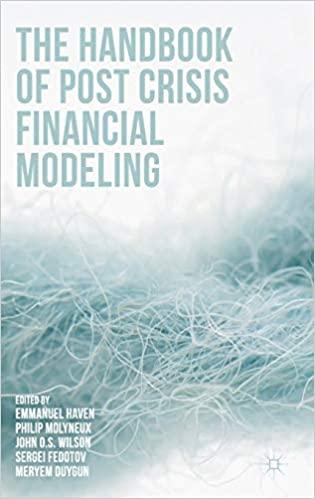Answered step by step
Verified Expert Solution
Question
1 Approved Answer
I've got the answers but need to know how to get them in an excel spreadsheet (formulas and equations): 12/7/12 Chapter: 12 Problem: 10 Start
I've got the answers but need to know how to get them in an excel spreadsheet (formulas and equations):
| 12/7/12 | ||||||||||||
| Chapter: | 12 | |||||||||||
| Problem: | 10 | |||||||||||
| Start with the partial model in the file Ch12 P10 Build a Model.xls on the textbooks Web site, which contains the 2013 financial statements of Zieber Corporation. Forecast Zeiber's 2014 income statement and balance sheets. Use the following assumptions: (1) Sales grow by 6%. (2) The ratios of expenses to sales, depreciation to fixed assets, cash to sales, accounts receivable to sales, and inventories to sales will be the same in 2014 as in 2013. (3) Zeiber will not issue any new stock or new long-term bonds. (4) The interest rate is 11% for long-term debt and the interest expense on long-term debt is based on the average balance during the year . (5) No interest is earned on cash. (6) Dividends grow at an 8% rate. (6) Calculate the additional funds needed (AFN). If new financing is required, assume it will be raised by drawing on a line of credit with an interest rate of 12%. Assume that any draw on the line of credit will be made on the last day of the year, so there will be no additional interest expense for the new line of credit. If surplus funds are available, pay a special dividend. | ||||||||||||
| a. What are the forecasted levels of notes payable and special dividends? | ||||||||||||
| Key Input Data: | Used in the | |||||||||||
| forecast | ||||||||||||
| Tax rate | 40% | |||||||||||
| Dividend growth rate | 8% | |||||||||||
| Rate on notes payable-term debt, rstd | 9% | |||||||||||
| Rate on long-term debt, rd | 11% | |||||||||||
| Rate on line of credit, rLOC | 12% | |||||||||||
| December 31 Income Statements: | ||||||||||||
| (in thousands of dollars) | ||||||||||||
| Forecasting | 2013 | 2014 | 2014 | |||||||||
| 2013 | basis | Ratios | Inputs | Forecast | ||||||||
| Sales | $455,150 | Growth | ||||||||||
| Expenses (excluding depr. & amort.) | $386,878 | % of sales | ||||||||||
| Depreciation and Amortization | $14,565 | % of fixed assets | ||||||||||
| EBIT | $53,708 | |||||||||||
| Interest expense on long-term debt | $11,880 | Interest rate x average debt during year | ||||||||||
| Interest expense on line of credit | $0 | |||||||||||
| EBT | $41,828 | |||||||||||
| Taxes (40%) | $16,731 | |||||||||||
| Net Income | $25,097 | |||||||||||
| Common dividends (regular dividends) | $12,554 | Growth | 8.00% | |||||||||
| Special dividends | $0 | |||||||||||
| Addition to retained earnings (DRE) | $12,543 | |||||||||||
| December 31 Balance Sheets | ||||||||||||
| (in thousands of dollars) | ||||||||||||
| Forecasting | 2013 | 2014 | 2014 | |||||||||
| 2013 | basis | Ratios | Inputs | Without adj. | Adj. | With Adj. | ||||||
| Assets: | ||||||||||||
| Cash | $18,206 | % of sales | ||||||||||
| Accounts Receivable | $100,133 | % of sales | ||||||||||
| Inventories | $45,515 | % of sales | ||||||||||
| Total current assets | $163,854 | |||||||||||
| Fixed assets | $182,060 | % of sales | ||||||||||
| Total assets | $345,914 | |||||||||||
| Liabilities and equity | ||||||||||||
| Accounts payable | $31,861 | % of sales | ||||||||||
| Accruals | $27,309 | % of sales | ||||||||||
| Line of credit | $0 | Previous | ||||||||||
| Total current liabilities | $59,170 | |||||||||||
| Long-term debt | $120,000 | Previous | ||||||||||
| Total liabilities | $179,170 | |||||||||||
| Common stock | $60,000 | Previous | ||||||||||
| Retained Earnings | $106,745 | Previous + DRE | ||||||||||
| Total common equity | $166,745 | |||||||||||
| Total liabilities and equity | $345,914 | |||||||||||
| Increase in spontaneous liabilities (accounts payable and accruals) | ||||||||||||
| + Increase in long-term bonds, preferred stock and common stock | ||||||||||||
| + Net income minus regular common dividends | ||||||||||||
| Increase in financing | ||||||||||||
| Increase in total assets | ||||||||||||
| Amount of deficit or surplus financing: | ||||||||||||
| If deficit in financing (negative), draw on line of credit | ||||||||||||
| If surplus in financing (positive), pay special dividend | ||||||||||||
| a. What are the forecasted levels of the line of credit and special dividends? | ||||||||||||
| Required ine of credit | Note: we copied values from G78:G79 when sales growth in G32 = 6%. | |||||||||||
| Special dividends | ||||||||||||
| b. Now assume that the growth in sales is only 3%. What are the forecasted levels of line of credit and special dividends? | ||||||||||||
| Required ine of credit | Note: we copied values from G78:G79 when sales growth in G32 = 3%. | |||||||||||
| Special dividends | ||||||||||||
Step by Step Solution
There are 3 Steps involved in it
Step: 1

Get Instant Access to Expert-Tailored Solutions
See step-by-step solutions with expert insights and AI powered tools for academic success
Step: 2

Step: 3

Ace Your Homework with AI
Get the answers you need in no time with our AI-driven, step-by-step assistance
Get Started


